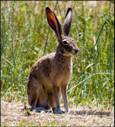
•
•Ecology
•They are true hares with precocial young. They are
considered both a "desirable"
(food, recreation) and "undesirable" (crop damage, competition with livestock) species
As with other species of rabbits and hares, L. californicus populations are known to fluctuate markedly, with alternating periods of local population increases and declines. Although these cycles can be rather dramatic, they appear to be considerably lower in magnitude than the frequently cited example of the snowshoe hares (L. americanus)
As with other species of rabbits and hares, L. californicus populations are known to fluctuate markedly, with alternating periods of local population increases and declines. Although these cycles can be rather dramatic, they appear to be considerably lower in magnitude than the frequently cited example of the snowshoe hares (L. americanus)
•It is not likely that individuals in the wild survive
more than seven years.
During the day, individuals rest in shallow depressions under vegetation called forms. These structures measure 10 to 20 centimeters in width, 30 to 45 centimeters in length, and 3 to 11 centimeters in depth.
During the day, individuals rest in shallow depressions under vegetation called forms. These structures measure 10 to 20 centimeters in width, 30 to 45 centimeters in length, and 3 to 11 centimeters in depth.
•
The characteristic long ears of the species demonstrate geographical variation in size occurring according to Allen's Rule.
The characteristic long ears of the species demonstrate geographical variation in size occurring according to Allen's Rule.
This general 'rule' predicts that
external appendages such as ears will be enlarged in warmer climates to facilitate radiation of heat back into the
air. The ears of L. californicus, on average, are larger in warmer climates than the ears of populations of L. californicus here in Oregon
L. californicus is well suited for a jumping style of locomotion. Individuals casually will move at a rate of 1.5 to 3 meters per jump, but can cover up to 10 meters when disturbed L. californicus can move at speeds of up to 56 kilometers per hour and jump as high as 1.5 meters.
L. californicus is well suited for a jumping style of locomotion. Individuals casually will move at a rate of 1.5 to 3 meters per jump, but can cover up to 10 meters when disturbed L. californicus can move at speeds of up to 56 kilometers per hour and jump as high as 1.5 meters.
